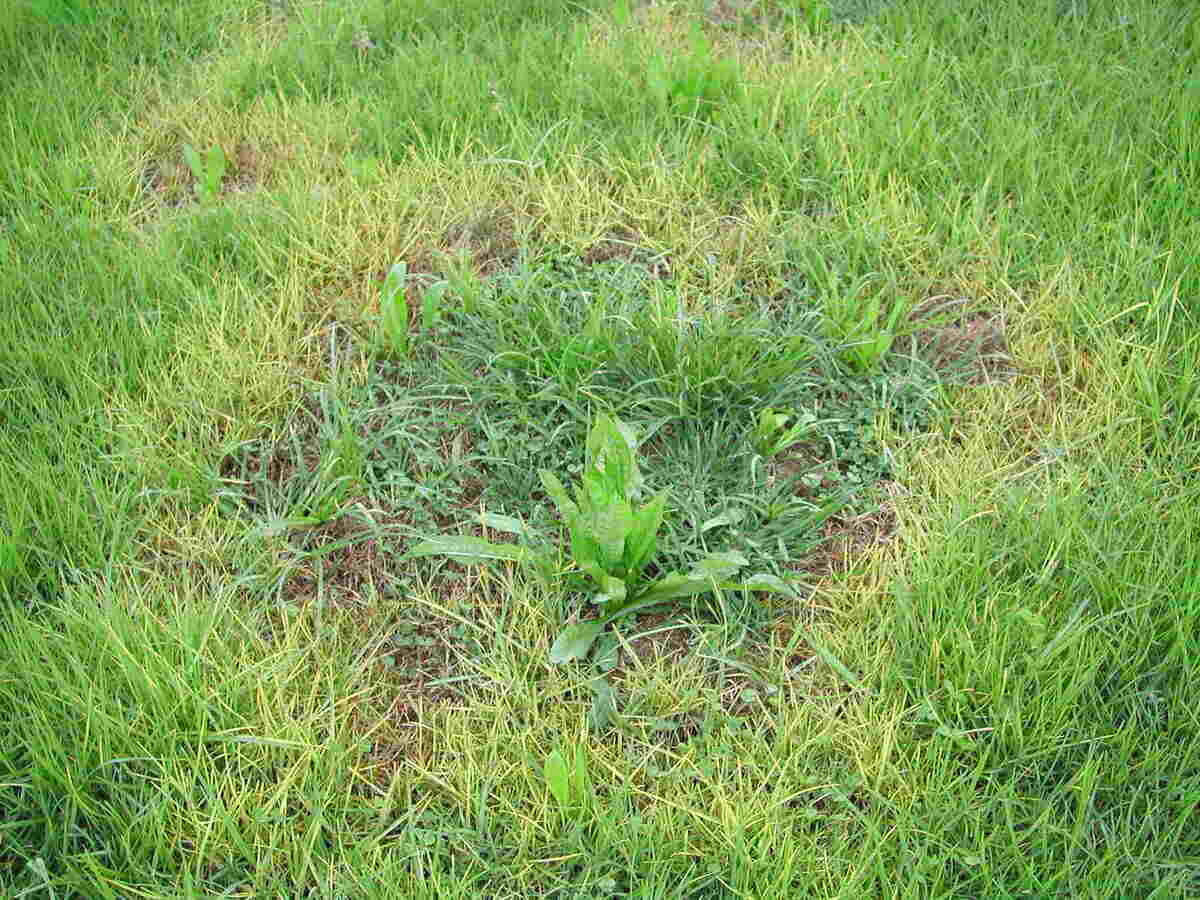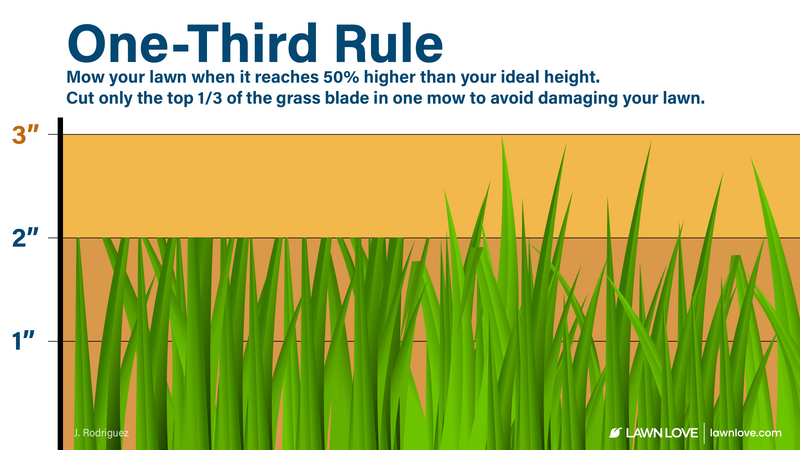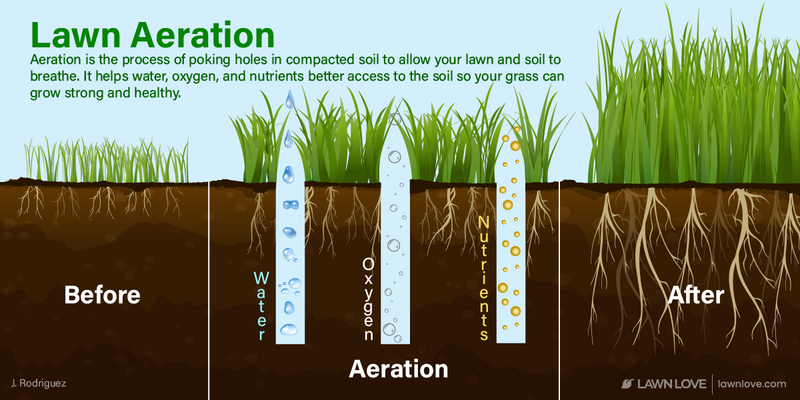
Don’t despair if you’ve recently seen brown patches on your lawn. In this guide on how to get rid of brown spots in your lawn, we’ll help you identify what causes brown spots and how to get to the root of the problem.
We’ll share lawn care tips that will help you prescribe a straightforward solution that can help your grass return to its former glory.
Common causes of brown spots and how to fix them
Before you can treat the brown patches in your lawn, you need to accurately diagnose the source of the problem. Most brown spot problems are caused by a fungus, environmental or maintenance issues, or insects.
Let’s explore the problems that cause brown patches and their common remedies.

1. Fungal diseases
Numerous fungal diseases can attack your lawn and cause it to turn brown. Fungi thrive in humid weather and can be a problem when water doesn’t evaporate from the grass leaves or when the soil doesn’t have good airflow.
Here are a few of the most common fungal diseases:
- Anthracnose
- Brown patch fungus
- Dollar spot
- Fairy ring
- Gray leaf spot
- Large patch
- Leaf spot
- Pythium blight/pythium root rot
- Rust
- Spring dead spot
- Summer patch
- Take-all root rot
Fostered by humid and hot conditions, brown patch disease might be one of the most common sources of brown spots in your lawn. Causes of brown patch include too much thatch, too much nitrogen, and compact soil. It is caused by the fungus Rhizoctonia.
Fungal diseases can be very difficult for homeowners to identify. The easiest way to confirm a diagnosis is to call an expert at your local Cooperative Extension office. Ask if you can send them a photo or bring in a sample of the grass blades.
Once you have identified the lawn disease, check out this report from the UGA Extension Office for detailed management recommendations. The North Carolina State Extension website has articles on how to manage fungal diseases, as well.
Solution: General advice for almost any fungal disease is similar:
- Balance your soil’s pH and nutrient levels.
- If your soil is compact, aerate your lawn.
- Dethatch when thatch level reaches three-fourths of an inch to allow for more airflow.
- Irrigate with 1 inch of water once per week. Don’t run your sprinklers after 10 a.m.
- Use fungicides as a last resort.
- Overseed areas where the grass has died.
You may not want to fertilize with an active fungus. Ask your Cooperative Extension agent for advice on the best practice for your lawn’s situation.
Note: With all of these recommendations, timing is important. Ask an expert to ensure you’re doing the right thing at the right time.

2. Improper mowing practices
Without proper mowing practices, your lawn may be more susceptible to disease. Here are some improper mowing practices you should avoid:
- DON’T scalp your lawn. Scalping your lawn refers to cutting off more than one-third of the grass blades during a mowing session.
- DON’T mow with a dull mower blade.
Solution: Mow to the highest recommended height for your grass type. Don’t cut more than one-third of the grass blade per mow, and sharpen your blade two to three times per year (unless you have a very long growing season, then you will want to sharpen it more often).
How do you know when to sharpen lawn mower blades? Look at the blades of grass after you mow. If the blades have a clean cut, you’re good. If the edge is ragged, it’s time to sharpen your blades.

3. Soil compaction
Compacted soil is detrimental to water and air circulation. Because of the density of compacted soil, grass roots can’t grow as deep and water doesn’t drain as well, which can lead to diseases in the root system.
For best practice, have your soil tested every so often to see if your yard has good soil or poor soil. Homeowners can purchase soil testing kits to help determine the quality of the soil. With these kits, you collect a sample of your soil and then send it to a local lab for analysis.
Solution: Aerate once per year or whenever you notice that the soil in your yard is compacted. To identify compacted soil, test it by sticking a screwdriver or shovel into the dirt. If the tool slides easily into the ground, the soil is fine. If there is resistance, your soil is likely compacted.
4. Excess thatch

Thatch is a layer of plant material between the living grass and the soil. Less than one-half inch of thatch or so on your lawn is fine, but anything over that can be detrimental to the lawn. It prevents water and fertilizer from getting to the roots and can harbor fungi and insects.
Solution: Dethatch the lawn once thatch buildup reaches one-half to three-fourths of an inch. Local home improvement rental centers usually rent dethatching machines. You also can use a detaching rake to remove the organic matter.
5. Excess fertilizer
If you inadvertently apply too much fertilizer to the lawn, it may burn your grass. The salts in the fertilizer, if overapplied, make it hard or impossible for the plant to take in water. Lawns suffer most from excessive nitrogen in times of drought.
Solution: Follow these steps to avoid over-fertilizing your yard:
- Hose down the affected areas until the ground is saturated. This helps the excess fertilizer to move out of the roots.
- Then apply 1 inch of water for the next three to four days (or up to a week) to rid the ground of the excess salts.
- Going forward, fertilize with slow-release nutrients, as these rarely cause burns. Or apply less than the recommended amount of a quick-release fertilizer.

6. Drought
Drought is a common problem. If your area is in a drought and has local watering restrictions, your grass may turn brown if it goes dormant.
You may think you have dead grass from the look of the lawn, but only in extreme conditions will the entire yard completely die. Dormancy is a self-protective state where the grass stops actively growing and turns brown.
Solution: Although you can continue to water your lawn one inch a week, homeowners can also choose to let their lawn go dormant by decreasing the amount they are watering to ½ inch every 1-2 weeks.
During a drought, mow your lawn less frequently and increase your mowing height to avoid putting additional stress on the grass. When you mow, leave the grass clippings on the lawn for additional moisture and root protection. Also, avoid walking on the lawn.
Check with your state’s Cooperative Extension office for local watering advice during drought conditions.
To keep your green grass during periods of drought, consider grass paint. This is an easy, DIY solution for unattractive, brown grass.
7. Dormancy
As we’ve mentioned above, dormant grasses stop growing and turn brown. Cool-season grasses go dormant in the summer while warm-season grasses go dormant over the winter. Once the temperatures change, the grasses turn green again and start growing.
Solution: None. Wait until the weather changes, or paint your lawn.

8. Pet urine
Dog urine can cause brown spots in your lawn due to its nitrogen content and other compounds that may affect the soil’s pH.
Solution: After the dog urinates, use the hose to diffuse the nitrogen in the soil. Besides this, you may consider decreasing the nitrogen in your routine fertilizing program.
Alternatively, you can train your pet to use the bathroom in a designated section of the yard. That way you will only have a small area of the yard to take care of and manage as needed.
9. Gasoline or chemical spill
If you have a substance spill on your lawn, it may kill the grass immediately and mar the curb appeal of your landscaping.
Solution: Be careful to avoid chemical spills when possible and always check chemical containers for leaks. Some spills are unavoidable, so in the event of a chemical spill, drench the affected soil with the hose for at least 20 minutes to dilute it.
After you have drenched the affected spot, add some fresh soil and overseed your grass at the appropriate time of year.
10. Overwatering or underwatering
Giving your grass too much water can result in a variety of problems that might ultimately lead to brown spots in your lawn. Excessive watering will leave puddles around your yard or invite fungal diseases such as brown patch.
On the other hand, depriving your lawn of the amount of water it needs also can cause brown patches, as your grass will start to wither and die.
Solution: If you notice signs your yard is being overwatered or underwatered, adjust your watering schedule accordingly.
- Overwatering: Reduce the amount of your waterings. This might involve shorter watering sessions or watering your lawns less days per week. Avoid watering late in the day, otherwise the water will sit on the grass overnight.
- Underwatering: Increase the amount of water and the number of watering sessions your lawn gets every week.

11. Insects
Grubs
Grubs, a type of beetle larvae, are a common cause of brown patches in the lawn. They are plump and white. If the grass in your yard is coming up in clumps, it might mean you have a grub infestation in your lawn.
Solution: Dig up a 12-inch square of grass to determine if you have grubs. In severe infestations, you may be able to roll up the turf like a carpet since grubs sever the roots in two as they feed.
If there are more than 6 grubs or so per foot, you may want to consider treatment. You can find conventional insecticides at your local home improvement store or contact an organic lawn care company that has experience using beneficial nematodes.
When treating grubs, timing is critical. The timing of your treatment depends on the type of grub you’re treating. Ask your lawn care pro or local Cooperative Extension agent to help you determine when and how to treat.
Here are a few tips to prevent grub damage:
- Choose resistant grass species. Endophyte-enhanced fescue and ryegrass (both cool-season grasses) are better able to resist billbug grubs. In warm-season areas, any grass that spreads aggressively (such as bermudagrass) recovers from grub damage more quickly and shows fewer signs of injury.
- Milky spore. Helps reduce Japanese beetle grubs, but is not effective for other beetle species.
- Encourage predatory species. Birds, ants, and wasps are natural grub predators.
- Warm-season grass. Warm-season grasses have an advantage over cool-season grasses since grubs prefer moist soils, so dry soils where warm-season grasses grow help discourage them from setting up shop.
- Introduce beneficial nematodes to your background. There are beneficial nematodes that prey on grubs that you can introduce to your yard.
Chinch bugs
Chinch bugs affect both cool- and warm-season lawns. In northern areas, chinch bugs feed on multiple types of turfgrass, including types such as:
- Bentgrass
- Kentucky bluegrass
- Perennial ryegrass
- Red fescues
- St. Augustinegrass
The feeding habits of chinch bugs render grass unable to reach the nutrients it needs to thrive, resulting in patchy brown spots in the lawn during the summer months.
Solution: In most cases, non-chemical strategies are effective. During hot, dry periods of the year, watering your grass deeply once per week will usually deter chinch bugs from feasting on your lawn.
Since chinch bugs feed on lawns with a thick layer of thatch, dethatching is another effective preventive control.
Insecticides are an option but are not necessary most of the time. One reason is that they will kill the chinch bugs’ main predator, the big-eyed bug. The controls mentioned above (watering and dethatching), are usually sufficient to prevent or treat any problems.
Other insects
Grubs and chinch bugs may not be the only insects that pose a threat to your lawn’s greeness. Look out for other insects such as billbugs and caterpillars that may cause your grass to brown.
Birds and wasps are natural predators of lawn insects, so if you see a lot of them hanging around your lawn, it might be because there are a lot of pests in your yard.
Solution: You might want to encourage natural predators to your lawn to get rid of bug pests. Consider putting up a bird feeder and bird bath to make your yard hospitable and welcoming for feathered friends.
The most orthodox treatment for lawn pests is to use chemical insecticides to eradicate nuisance insects in your yard.
12. Objects left in the yard
Generally, grass thrives best when it is exposed to lots of direct sunlight, so grass withers if any objects are sitting on top of it too long. If you leave toys or equipment out on your lawn for a bit, the grass will start to turn brown.
Solution: Keeping your lawn clean and debris-free is the simple solution to avoid brown spots caused by objects lying around the yard. Remove any objects you have sitting out in the yard, including:
- Chairs
- Equipment
- Garden hoses
- Swimming pools
- Tools
- Toys
13. Heavy foot traffic

Not all grasses are good with a lot of foot traffic. Some types of turfgrasses have good resistance to foot traffic, but other types are much less resilient and will quickly wither under heavy foot traffic.
Solution: Reduce the amount of traffic that goes through your yard. In extreme cases, homeowners might want to consider switching to a more durable turfgrass that holds up under heavy levels of foot traffic.
FAQs about getting rid of brown spots
How do I tell if grass is dead or dormant?
If your grass has started browning, don’t panic. In most cases, the turfgrass will come back once you find the solution to the problem causing the grass to turn brown.
However, in extreme cases, grass can die and you will be required to plant new grass, so here’s the differences to look for in determining if you grass is dead or dormant:
- Dead grass will be lifeless and might not stand upright anymore. Dormant grass retains its springiness despite its brown color.
- You can easily pull out dead grass. Dormant grass will still resist being pulled out.
- Water your brown lawn for a few days. If it starts to come back, it means that it was merely dormant. If it stays brown, your turfgrass is dead.
- When a lawn goes dormant, the change is usually uniform and the whole lawn turns brown at the same rate. If only patches of your lawn are browning, it probably means you have a brown spot problem.
Tip: In summer droughts, the lawn will often turn brown, so don’t be alarmed if your yard goes dormant during the hot season. Sometimes homeowners will intentionally let their yard go dormant during these dry spells to conserve water.
Will lawn fungus go away on its own?
No, a lawn fungus will not go away on its own. You must take action against lawn fungi and treat them with fungicides to help restore your green grass.
Which fungicide is best for treating brown patch fungus?
For an organic solution for treating brown patch fungus, use a fungicide product containing the active ingredient bacillus amyloliquefaciens strain D747.
Other chemical treatments for brown patch fungus should include one of these ingredients:
- Azoxystrobin (alone or with Propiconazole)
- Fluoxastrobin
- Pyraclostrobin with Triticonazole
Get back your lush, green lawn
Unsightly brown patches are a detriment to a green, healthy lawn, but they don’t have to be the bane of your existence. When you find brown spots in your yard, diagnose the pro blem, use one of our recommended solutions, and practice good preventive lawn care.
If you’d rather have a professional set of eyes from the get-go, consider hiring a lawn care professional who can diagnose and treat your lawn’s brown patches with accuracy and efficiency.
Main Photo Credit: Harry Rose | Flickr | CC BY 2.0